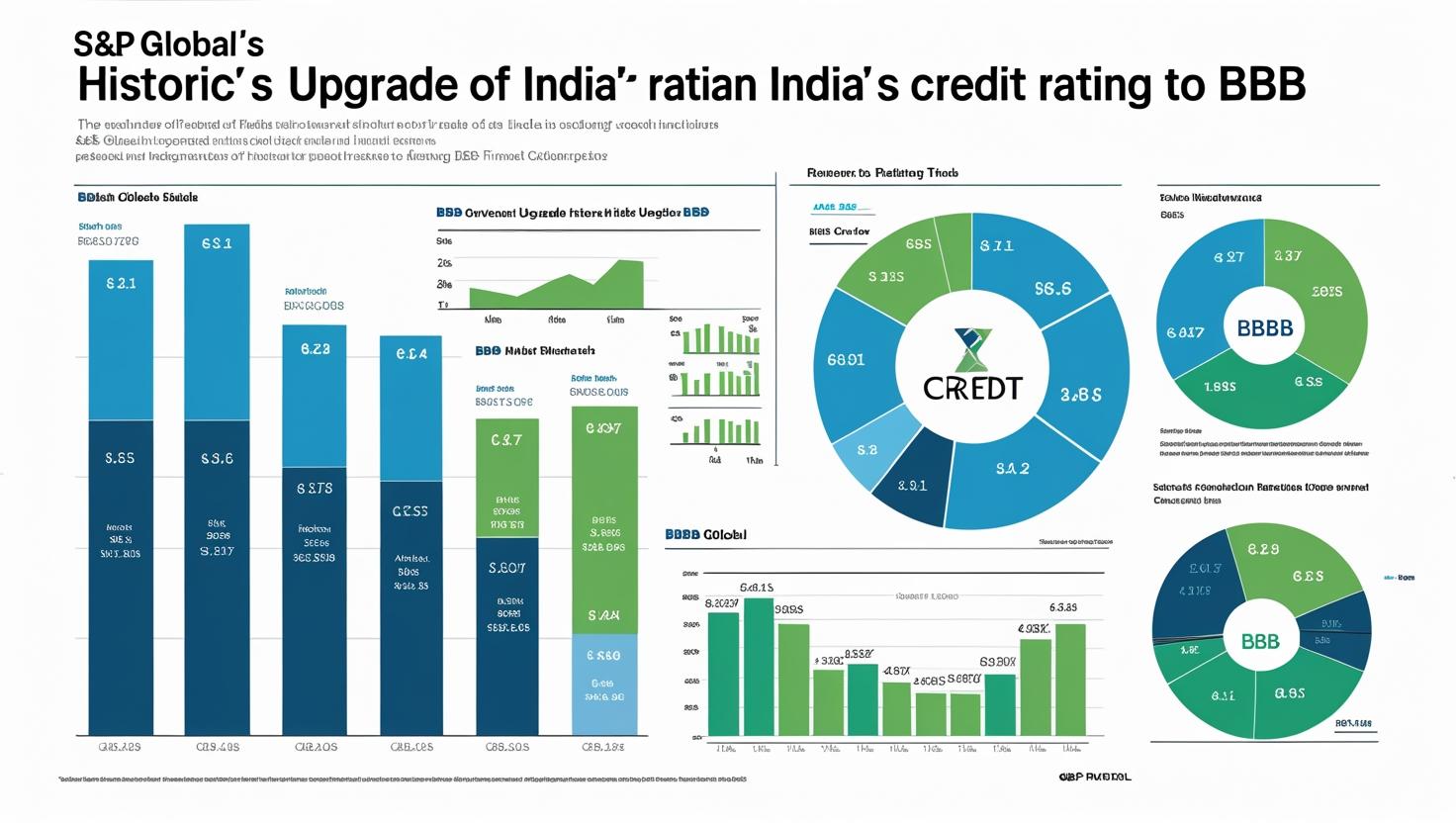New Delhi, August 15, 2025 – In a historic move, S&P Global Ratings has upgraded India’s long-term unsolicited sovereign credit rating to “BBB” from “BBB-” with a Stable Outlook, marking the country’s first such upgrade since January 2007. The decision, announced on August 14, 2025, reflects India’s robust economic resilience, sustained fiscal consolidation, and effective monetary policy management, even amid challenging global trade conditions and rising U.S. tariffs.
Why This Upgrade Matters
Credit ratings assigned by agencies like S&P Global, Moody’s, and Fitch play a pivotal role in determining a country’s borrowing costs, foreign investment appeal, and overall perception in global financial markets. India’s move from BBB- (the lowest investment grade) to BBB signals a significant improvement in its macroeconomic fundamentals.
A Stable Outlook indicates that S&P does not anticipate any immediate rating changes in the near term, reflecting confidence in India’s policy stability and economic trajectory.
Key Drivers of the Upgrade
1. Strong Economic Resilience
S&P acknowledged India’s ability to maintain one of the fastest growth rates among major economies.
- Between FY 2022 and FY 2024, India’s real GDP growth averaged 8.8%, the highest in the Asia-Pacific region.
- For FY 2025–26, S&P projects growth at 6.5%, driven by domestic demand, public infrastructure investment, and a growing manufacturing base under “Make in India” initiatives.
India’s large consumer base has acted as a buffer against global demand shocks, making the economy less vulnerable to external trade fluctuations.
2. Sustained Fiscal Consolidation
Fiscal discipline has been a cornerstone of this upgrade.
- The central government fiscal deficit has steadily reduced, and the combined state and central deficit is expected to fall from ~7.3% of GDP in 2025–26 to 6.6% by 2028–29.
- Improved quality of public expenditure—with higher capital expenditure on roads, railways, ports, and renewable energy projects—has increased the multiplier effect on growth.
3. Monetary Policy Credibility
India’s inflation-targeting framework, operated by the Reserve Bank of India (RBI), has improved policy predictability and anchored inflation expectations.
S&P noted that:
- Inflation has remained largely under control despite food price volatility.
- Interest rate policies have balanced growth support with price stability.
4. Stronger External Position
S&P upgraded India’s transfer and convertibility assessment to A- from BBB+, citing:
- Comfortable foreign exchange reserves exceeding USD 650 billion.
- Manageable current account deficits, largely financed by stable capital inflows and foreign direct investment (FDI).
- Rising service exports, particularly in IT and professional services.
Impact of U.S. Tariffs
Interestingly, this upgrade came despite the U.S. imposing higher tariffs—up to 50%—on certain Indian exports.
S&P’s analysis suggests:
- The impact will be “manageable” due to India’s low dependence on exports (goods exports are around 13% of GDP).
- Strong domestic consumption and growing intra-Asia trade links will cushion potential export losses.
This contrasts with several emerging markets more dependent on U.S. trade, where tariff impacts have been more severe.
Government’s Response
The Finance Ministry welcomed the upgrade, stating:
“This recognition by S&P Global validates India’s sound macroeconomic policies, fiscal discipline, and resilient growth model. The government remains committed to continuing reforms and infrastructure investments to sustain this momentum.”
Finance Minister Nirmala Sitharaman highlighted that the rating upgrade will likely:
- Lower sovereign borrowing costs.
- Improve foreign investor sentiment.
- Support the rupee and capital markets.
Market Reaction
The upgrade had an immediate positive effect on Indian financial markets:
- Rupee appreciated by around 0.4% against the U.S. dollar.
- Government bond yields declined, reflecting expectations of reduced borrowing costs.
- Equity markets saw gains in banking, infrastructure, and capital goods stocks, which stand to benefit from increased investment flows.
Historical Context
This is India’s first rating upgrade from S&P in 18 years:
- January 2007 – S&P upgraded India to BBB-.
- 2009–2020 – Ratings remained unchanged, even amid global financial turbulence and COVID-19.
- 2025 – Upgrade to BBB, reflecting structural improvements.
Comparison with Other Agencies
| Agency | Current Rating | Outlook | Last Change |
|---|---|---|---|
| S&P Global | BBB | Stable | Upgrade, Aug 2025 |
| Moody’s | Baa3 | Positive | Nov 2023 Outlook Upgrade |
| Fitch | BBB- | Stable | Affirmation, Dec 2024 |
S&P’s move now places India one notch above Fitch’s rating and in line with Moody’s “Baa3” (which is equivalent to BBB).
Potential Benefits of the Upgrade
- Lower Borrowing Costs – Both sovereign and corporate debt issuances can see reduced yields, making it cheaper for the government and companies to raise capital.
- Boost to FDI – Institutional investors who are restricted to investment-grade assets may now increase exposure to India.
- Stronger Rupee Support – Improved confidence in macro stability could limit currency volatility.
- Bond Index Inclusion – The upgrade strengthens the case for higher weightage of Indian bonds in global indices.
Risks S&P Will Monitor
While optimistic, S&P flagged certain watchpoints:
- Fiscal slippage due to populist spending or revenue shortfalls.
- Geopolitical risks in the region.
- Climate-related shocks affecting agriculture and energy demand.
- Global monetary tightening, which could affect capital flows.
Economist Perspectives
Economists widely view this as a confidence-boosting milestone:
- Radhika Rao, Economist at DBS Bank, noted: “The upgrade reflects policy continuity and India’s ability to sustain high growth without compromising fiscal discipline.”
- Sonal Varma, Chief Economist at Nomura, stated: “India now stands out among emerging markets as a macroeconomic outperformer. The challenge is to maintain reform momentum.”
Long-Term Outlook
S&P’s Stable Outlook suggests no immediate change is expected in the next 12–24 months, but further upgrades are possible if:
- Growth consistently exceeds forecasts.
- Fiscal deficit falls faster than projected.
- Structural reforms in labor, land, and taxation boost productivity.
Conclusion
S&P Global’s historic upgrade to BBB is a resounding endorsement of India’s economic resilience, prudent fiscal management, and reform trajectory. Coming at a time when global trade tensions and protectionism are rising, this move reinforces India’s position as one of the most attractive destinations for global investment in the coming decade.
With a growing consumer base, large-scale infrastructure push, and credible monetary policy, India’s economic narrative is shifting from potential to performance.




